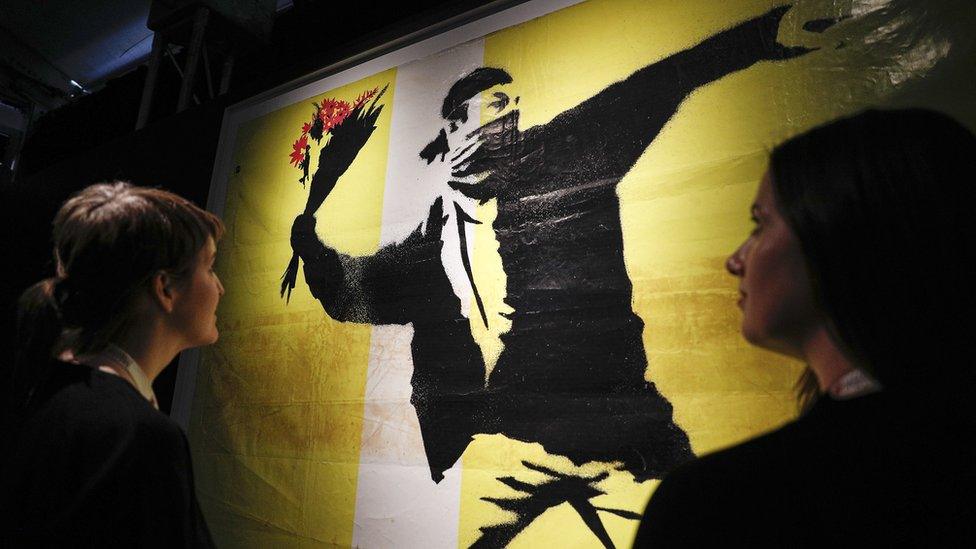Banksy's urban tree artwork defaced with white paint
- Published
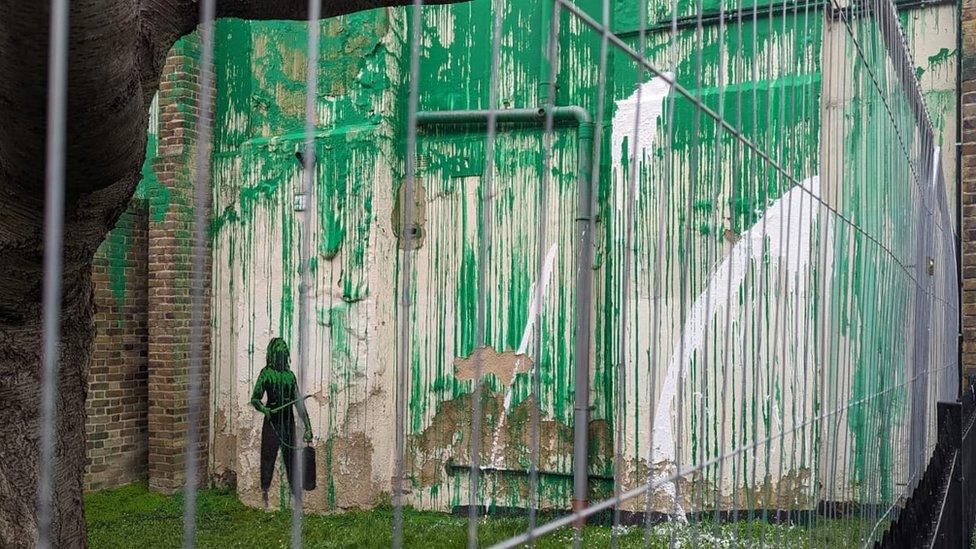
The artwork appeared over the weekend in Finsbury Park - but it has been defaced with white paint
A mural painted by street artist Banksy on a residential building in north London has been defaced.
The artwork appeared over the weekend featuring swathes of green paint on a wall behind a nearby tree to give the appearance of leaves.
But by Wednesday morning, the artwork, surrounded by a protective metal fence, had been strewn with white paint.
Islington Council said it was installing CCTV cameras and looking at other ways to protect the work.
A spokesperson said the authority welcomed the piece, adding: "We very much want it to stay."

The tree before and after it was cut back, and the Banksy mural before it was apparently daubed with white paint
They added: "This is a really powerful piece, which highlights the vital role that trees play in our communities and in tackling the climate emergency. It's sad to see the piece has been defaced."
When the mural first appeared, "we moved quickly to put in place temporary measures to protect it and manage the crowds, such as installing fencing and having visits from park patrol officers".
The council was discussing "future solutions" with the homeowner "to enable everyone to enjoy the artwork".
On Monday, Banksy claimed the mural as his own following speculation after it appeared on a building on Hornsey Road in Finsbury Park.

Carlos Serrano found himself living in the middle of the Banksy display
Local resident and journalist Carlos Serrano said discovering a Banksy right beside his flat had led to some "crazy days". His window now lies within the fenced off area which protects the street art.
He told the BBC London: "I really feel really happy about this because I think this is just like an opportunity to meet new people, to feel like I'm really part of this community."
Mr Serrano added: "This is private property and we are living here - we want to preserve our privacy - I think that's important - but at the same time it's important for people to enjoy this kind of thing."
'Real shame'
Streams of people travelled to see the artwork, but local resident Matt McKenna, 35, told BBC London he was out walking his dog on Wednesday morning when he saw the white paint across the mural.
"It is a real shame. It happened overnight," he said. "When it appeared on Sunday my partner saw it and said she quite liked it before everyone was talking about it.
"It has got lots of people talking and it is a bit of London which is a bit forgotten at times."
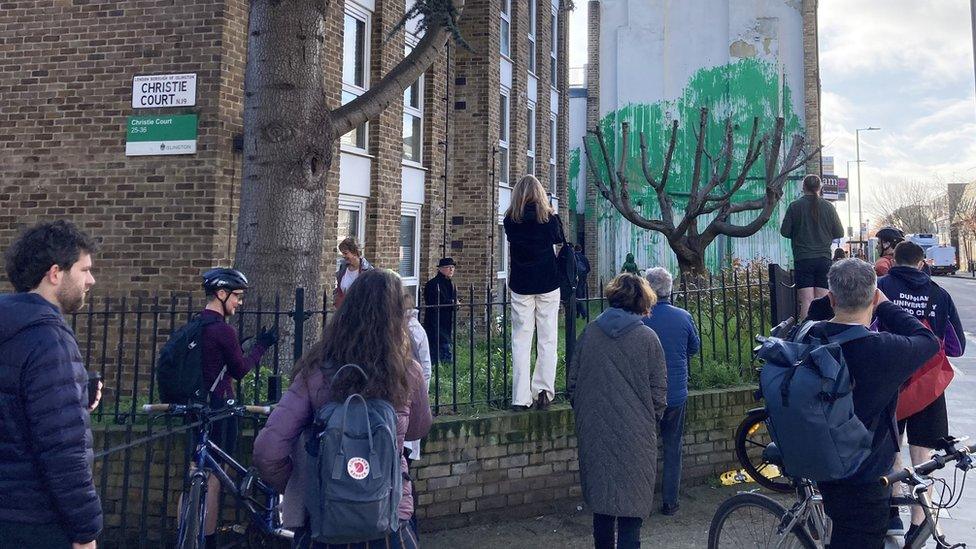
Streams of people travelled to Finsbury Park to see Banksy's artwork since it first appeared over the weekend
As yet, the person responsible for the white paint has not been identified.
Speaking on the BBC podcast "The Banksy Story" earlier in the week, graffiti artist Joe Epstein, from LDN Graffiti, explained graffiti artists often had "turf wars" that could see them "taking out each other's pieces".
He said: "Part of the story of these pieces is how people add to it or are aggressive towards it or aligned with it."

Retired local art teacher Don Campbell spoke to BBC London about his thoughts on the white paint
Retired local art teacher Don Campbell told BBC London he thought the white paint "kind of adds to it and distracts from it as well, at the same time".
"It's part of the history of just what can happen in a few days or so," he said.
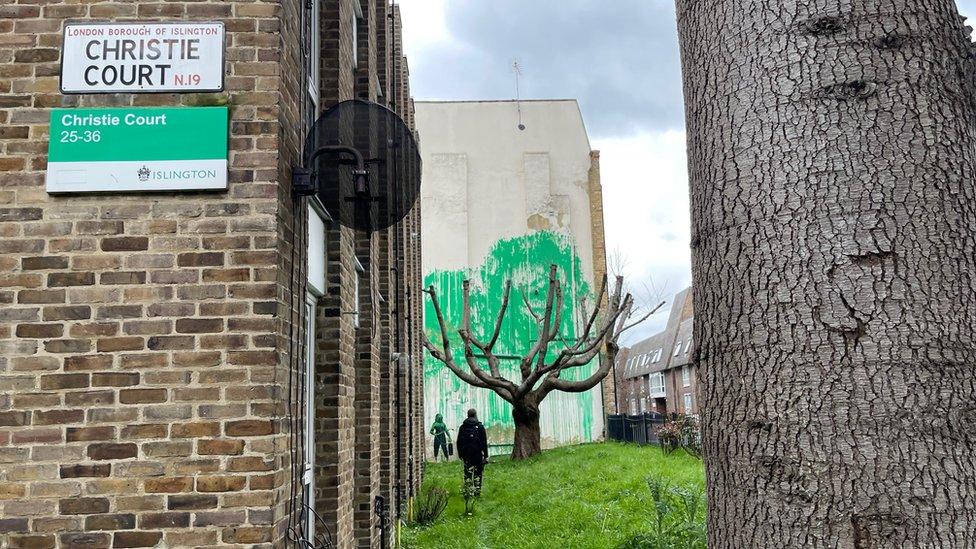
The colour used for the artwork, seen here before it was daubed with white paint, is the same as that of the Islington Council signs
As with many of Banksy's works, the latest piece caused a debate and range of opinions, including from some conservation campaigners who say the Cherry tree was pruned back, or pollarded, too much.
Gio Lozzi, from Haringey Tree Protectors, said the Cherry tree had been cut back "really, really, really brutally".
"Cherry trees do not respond well to this kind of pollarding," she said.
"It should be in blossom, it should be in full blossom, it's March."
Islington Council explained the cherry tree chosen by Banksy was 40 to 50 years old and in declining health, with decay and fungi damage.
The local authority said it would continue to work to try to keep the tree alive and that it should re-bud across its crown.
The boss of the firm responsible for pruning the tree back to its current shape on behalf of the council said his team had used an "ancient form of pruning", known as pollarding, where the upper parts of the tree were removed.
Lawrence-Thor Stephen, who runs Thor's Trees, explained the practice limited the tree's growth and stopped weak branches from falling off.
He said it was a "really good way of increasing the lifespan of the tree" and that he hoped it would "burst with growth in the spring".

Listen to the best of BBC Radio London on Sounds and follow BBC London on Facebook, external, X, external and Instagram, external. Send your story ideas to hello.bbclondon@bbc.co.uk, external
Related topics
- Published19 March 2024
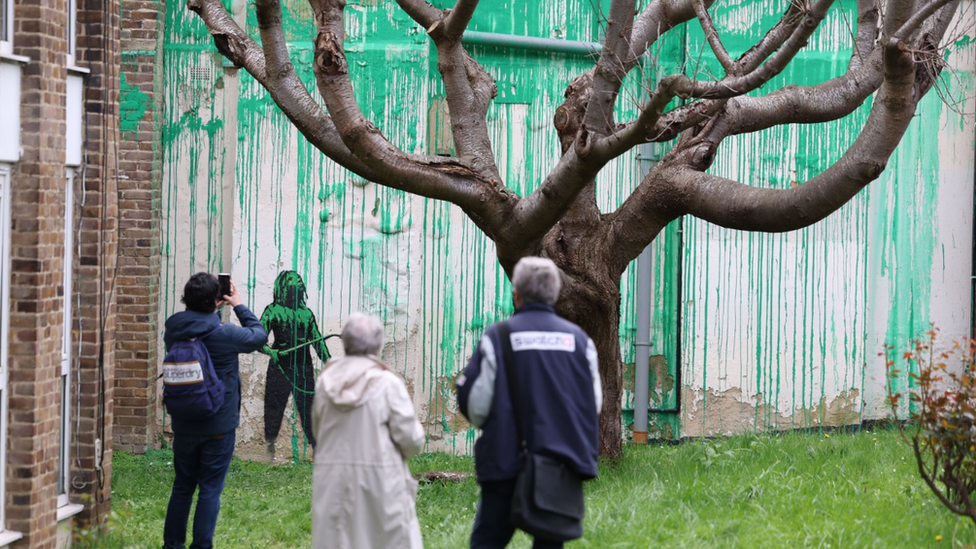
- Published18 March 2024

- Published13 August 2024
